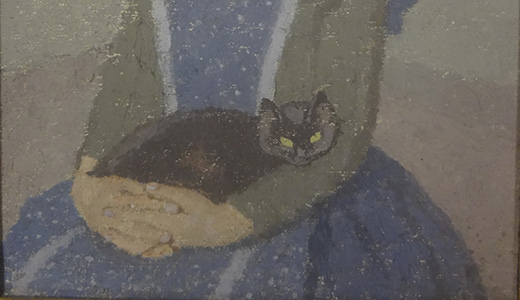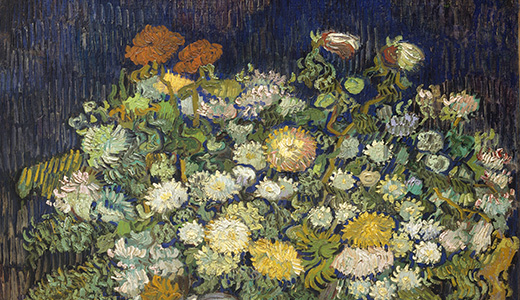 2017
2017
Girl with a Cat (detail), by Gwen John, c. 1918. The Metropolitan Museum of Art, Bequest of Joan Whitney Payson, 1975.
On November 28, the online game CryptoKitties debuted on Ethereum, a cryptocurrency network that allows users to buy virtual goods with Ether. Five days later, someone spent $117,712 on one of what the developers call “breedable Beanie Babies,” which the BBC reported included cats that were “lifelike, with grey striped fur and bulging green eyes" as well as those "speckled with neon-blue spots or magenta-patterned swirls.” Hardly more than a week later, more than $3 million has been spent on the kitties. The game is so popular—accounting for about 11 percent of Ethereum traffic—that it is slowing down transactions on the network. TechCrunch analyzed the bubbling trend on December 3:
So now we have people using Ether, an asset with arguably little tangible utility—to purchase an asset with unarguably zero tangible utility. Welcome to the internet in 2017.
In all seriousness, it’s a little bit reminiscent of the Beanie Baby trend where people were paying insane amounts of money for stuffed animals. But if the popularity continues to increase these people may be able to make a return by reselling or breeding their rare kittens, or they’ll be stuck holding the virtual cryptographic keys to a virtual rare kitten when the market crashes in a few days, like eventually happened with Beanie Babies. There are a few cool things about the game though, and putting aside the valuation absurdity it’s actually a cool way for beginners to interact with the Ethereum blockchain. First off, it’s important to understand that since it’s played on the Ethereum blockchain there’s no central entity managing the game. This means users literally own their kittens.
Unlike playing Neopets where everything was stored on a central database and your pet was deleted when the company shut down, CryptoKitties is decentralized and will live forever on the Ethereum blockchain…Kittens can also be created by breeding them, which the game calls Siring. You can put your own kitten up for sire for a specified amount of ether and someone can breed with it, and they get the offspring and you get the ether. Or, you can pay to breed your cat with someone else’s and you keep the offspring and they keep the ether. It can take anywhere from an hour to a week in “cooldown time” to breed a new kitten. The shorter the time the better, since you can sell the offspring sooner and breed again. This means kittens with shorter cooldown time usually sell for more. Each kitten has a 256-bit genome that holds the genetic sequence to all the different combinations kittens can have. These include things like background color, cooldown time, whiskers, beards, stripes and so on. Some of these genes can be recessive, meaning a kitten without stripes could still breed one with stripes. It’s important to note that there’s no “rare scale” established by the game that assigns rarity values to these genetic sequences. That means the community is independently deciding what traits are rare by paying a premium for them. For example, kittens with a gold background have been selling more than kittens with other colors.
 c.
1637
c.
1637
Bouquet of Flowers in a Vase, by Vincent van Gogh, 1890. The Metropolitan Museum of Art, The Walter H. and Leonore Annenberg Collection, Gift of Walter H. and Leonore Annenberg, 1993, Bequest of Walter H. Annenberg, 2002.
In 1637, a few years after the height of the most recent plague, a Dutch priest warned his nephew that “another sickness has arisen.” He was referring to tulipmania, the floral frenzy that has an outsize reputation in the history of regrettable financial bubbles. According to Tulipmania: Money, Honor, and Knowledge in the Dutch Golden Age by Anne Goldgar, however, the fad, like most fads, was more of a blip than a crisis: “Although it was a craze, although it was a wonder, although it was much talked of at the time and ever after, most of what we have heard about it is not true. Not everyone was involved in the trade, and those who were were connected to each other in specific ways.” The popular memory of tulipmania was mostly constructed by Charles Mackay in his 1841 book Extraordinary Popular Delusions and the Madness of Crowds. Today its tallies of what people were willing to pay for a brief moment in the pop-culture tailwinds feels familiar:
Many persons grow insensibly attached to that which gives them a great deal of trouble, as a mother often loves her sick and ever-ailing child better than her more healthy offspring. Upon the same principle we must account for the unmerited encomia lavished upon these fragile blossoms. In 1634, the rage among the Dutch to possess them was so great that the ordinary industry of the country was neglected, and the population, even to its lowest dregs, embarked in the tulip trade. As the mania increased, prices augmented, until, in the year 1635, many persons were known to invest a fortune of 100,000 florins in the purchase of forty roots. It then became necessary to sell them by their weight in perits, a small weight less than a grain. A tulip of the species called Admiral Liefken, weighing 400 perits, was worth 4400 florins; an Admiral Van der Eyck, weighing 446 perits, was worth 1260 florins; a Childer of 106 perits was worth 1615 florins; a Viceroy of 400 perits, 3000 florins, and, most precious of all, a Semper Augustus, weighing 200 perits, was thought to be very cheap at 5500 florins. The latter was much sought after, and even an inferior bulb might command a price of 2000 florins. It is related that, at one time, early in 1636, there were only two roots of this description to be had in all Holland, and those not of the best. One was in the possession of a dealer in Amsterdam, and the other in Harlaem. So anxious were the speculators to obtain them, that one person offered the fee-simple of twelve acres of building-ground for the Harlaem tulip. That of Amsterdam was bought for 4600 florins, a new carriage, two grey horses, and a complete suit of harness. Hunting, an industrious author of that day, who wrote a folio volume of one thousand pages upon the tulipomania, has preserved the folio wing list of the various articles, and their value, which were delivered for one single root of the rare species called the Viceroy: